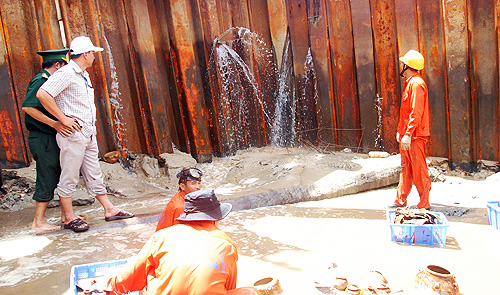Besides diving down to the seabed to pick up items or using machines to blow away sand at low tide, those who hunt for treasure in the ocean have another, more advanced method – closing off an area at sea and drying it up to expose antiques.
However, this technique is only applicable in shallow water, around five meters deep.
Doan Anh Duong Company has mastered the method to search for antiques from ancient shipwrecks and hopefully collect tens of thousands of items buried under the seabed for centuries.
A wrecked ship that was discovered in Chau Thuan Bien last September was the first vessel to be completely exposed thanks to the technique. The company built a waterproof lining of iron bars around the shipwreck and then pumped water out of the box.
This allows antique hunters to pick out items in the sea as if they are on land, but requires months of preparation. It took the company nine months to build this ‘box’ around the Chau Thuan Bien shipwreck.
Before starting to build the iron box, the company hired an agency to conduct a geological survey before drilling the bars deep into the seabed. Each iron bar was at least 12 meters long, with eight meters pinned in the sand the remaining four meters emerging above the surface, said Doan Sung, a consultant of Doan Anh Duong.
The bars are then connected with one another, forming a waterproof barrier before water is pumped out of the box, he added. The size of the box depends on the location of underground stones possibly lying below the seabed.
Subterranean streams may also affect the procedure, Sung revealed.
After the mud and sand were all blown away, the entire ship, which was 25 meters long, was exposed, along with the ceramic items it held, inside the 300 square meter box. Waves continually crashed into the wall from outside.
“This expensive method helps protect both the wrecked ship and the antiques of great values” said Sung.
If a ship lies under 30-70 meters of water, this technique cannot be applied. In such a case the only way is to send divers down, Sung said.
The antiques and wooden planks of the ship had burn marks, revealing that it either caught fire in an accident or was hijacked and burnt.
The waters of Chau Thuan Bien hamlet in Binh Son District of Quang Ngai Province in the central region were heavily used by captains sailing to and from Vietnam centuries ago thanks to its geographical features of locating on the ancient ‘Ceramic Road’ – formerly a trade route linking the Orient and the Occident.
Though this area lies in a bay covered by a five kilometer arc of mountains, it is not a safe region because the arc catches violent seasonal monsoon winds blowing to the northeast. The arc often suffers from high offshore waves.
In addition, at both ends of the arc lies an expanse of reef that can sink ships at low tide, especially centuries ago before sonar was invented.
‘Birthplace’ of fake antiques
As Chau Thuan Bien has become famous as the home of antiques collected from shipwrecks, fake antiques have been transported there to cheat ‘newcomers’ in the industry.
The fake goods were even buried in mud for years before people pretend to lift them out of the water ‘at the site of excavation’.
This is the result of illegal excavation of antiques offshore that authorities were not informed of. A lawful registry for excavation requires companies or individuals to share 30 percent of the total of the value with local authorities.

























































